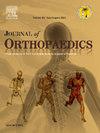Long-term functional outcomes of BIFOLD osteosynthesis in distal femoral fractures with metaphyseal comminution: A retrospective analysis
IF 1.5
Q3 ORTHOPEDICS
引用次数: 0
Abstract
Background
This retrospective study aimed to evaluate the long-term functional outcomes of BIFOLD osteosynthesis, employing retrograde nailing and distal femoral locked plating, in patients with distal femoral fractures and metaphyseal comminution.
Methods
A retrospective analysis was conducted on patients treated for distal femur fractures with metaphyseal comminution between 2012 and 2022, with a minimum follow-up of 2 years. Inclusion criteria encompassed distal femur fractures with metaphyseal comminution, excluding specific conditions. BIFOLD osteosynthesis was employed in all 33 cases, utilizing retrograde SIGN (Surgical Implant Generation Network Nail) and distal femoral locking plates. Primary outcome measures included radiographic and functional outcomes assessed through the Sanders functional evaluation score, with secondary outcomes focusing on perioperative or postoperative complications.
Results
A total of 33 patients (21 male, 12 female) were included, with an average age of 51.4 years. BIFOLD osteosynthesis exhibited an average radiographic fracture healing time of 6.2 ± 2.5 months. The procedure's average operative time was 100 ± 15 min, and blood loss averaged 420 ± 50 ml. According to Sanders criteria, 28 patients (84.84 %) demonstrated well-to-excellent functional outcomes, while 3 patients (9.09 %) reported fair outcomes, and 2 patients (6.06 %) reported poor outcomes. No significant shortening or implant failure occurred, and all patients achieved over 90 degrees of knee range of motion within 8 weeks. One patient experienced superficial infection, and two patients exhibited insignificant coronal plane deformity.
Conclusion
BIFOLD osteosynthesis, combining intra and extra medullary fixation principles, offers a stable construct for distal femoral fractures with metaphyseal comminution. This approach facilitates faster ambulation, pain relief, early knee joint mobilization, and significant early union, resulting in improved functional outcomes. Additionally, BIFOLD osteosynthesis helps prevent collapse, translational and rotational deformities, as well as shortening.
BIFOLD骨合成术治疗股骨远端骨折伴骨骺粉碎的长期功能效果:回顾性分析
背景这项回顾性研究旨在评估采用逆行钉和股骨远端锁定钢板的BIFOLD骨合成术对股骨远端骨折伴骨骺粉碎患者的长期功能疗效。方法对2012年至2022年间接受治疗的股骨远端骨折伴骨骺粉碎患者进行回顾性分析,随访时间至少2年。纳入标准包括股骨远端骨折伴骨骺粉碎,不包括特殊情况。所有33个病例都采用了BIFOLD骨合成术,使用逆行SIGN(外科植入物生成网络钉)和股骨远端锁定钢板。主要结果指标包括通过桑德斯功能评价评分评估的影像学和功能结果,次要结果指标主要是围手术期或术后并发症。BIFOLD 骨合成术的平均骨折愈合时间为 6.2±2.5 个月。平均手术时间为 100 ± 15 分钟,平均失血量为 420 ± 50 毫升。根据桑德斯标准,28 名患者(84.84%)的功能结果为良好至优秀,3 名患者(9.09%)的结果为一般,2 名患者(6.06%)的结果为差。没有发生明显的缩短或植入失败,所有患者在 8 周内膝关节活动范围均达到 90 度以上。结论BIFOLD骨合成术结合了髓内和髓外固定原理,为骨骺粉碎的股骨远端骨折提供了一种稳定的结构。这种方法有助于加快活动、减轻疼痛、早期膝关节活动和显著的早期愈合,从而改善功能结果。此外,BIFOLD 骨合成术还有助于防止塌陷、平移和旋转畸形以及缩短。
本文章由计算机程序翻译,如有差异,请以英文原文为准。
求助全文
约1分钟内获得全文
求助全文
来源期刊

Journal of orthopaedics
ORTHOPEDICS-
CiteScore
3.50
自引率
6.70%
发文量
202
审稿时长
56 days
期刊介绍:
Journal of Orthopaedics aims to be a leading journal in orthopaedics and contribute towards the improvement of quality of orthopedic health care. The journal publishes original research work and review articles related to different aspects of orthopaedics including Arthroplasty, Arthroscopy, Sports Medicine, Trauma, Spine and Spinal deformities, Pediatric orthopaedics, limb reconstruction procedures, hand surgery, and orthopaedic oncology. It also publishes articles on continuing education, health-related information, case reports and letters to the editor. It is requested to note that the journal has an international readership and all submissions should be aimed at specifying something about the setting in which the work was conducted. Authors must also provide any specific reasons for the research and also provide an elaborate description of the results.
 求助内容:
求助内容: 应助结果提醒方式:
应助结果提醒方式:


